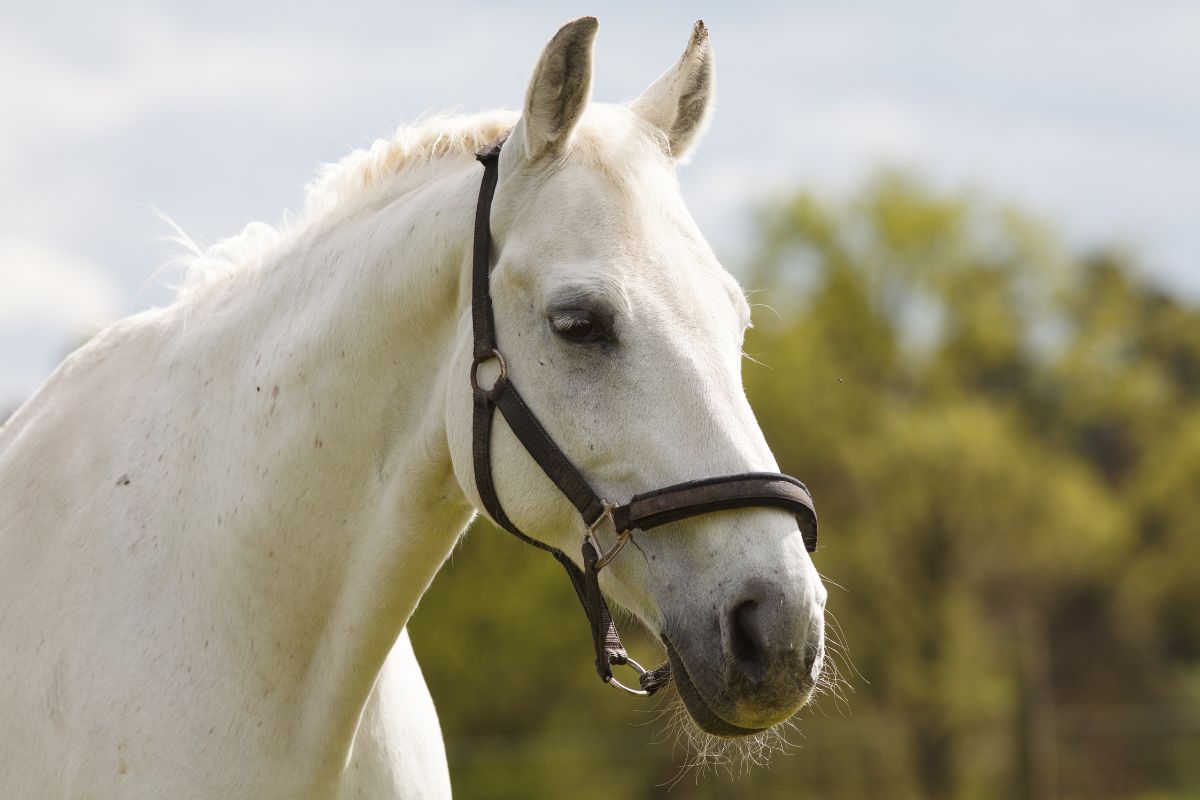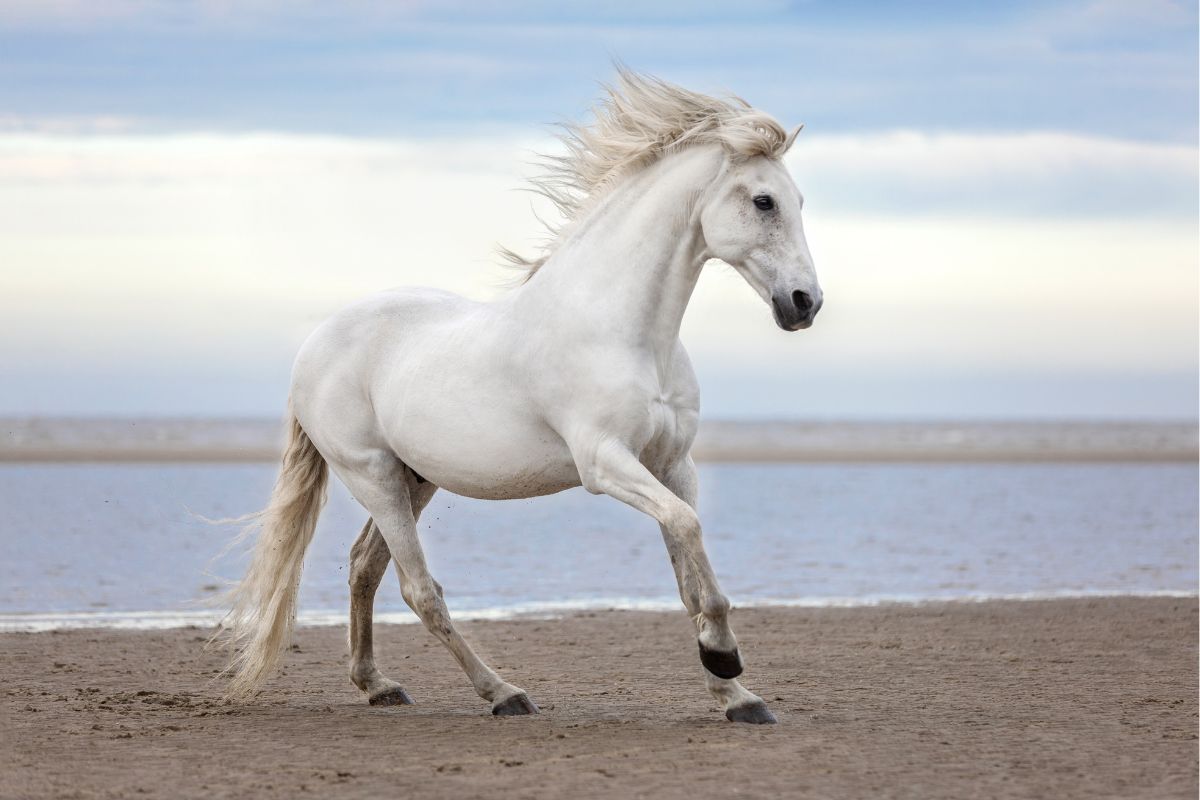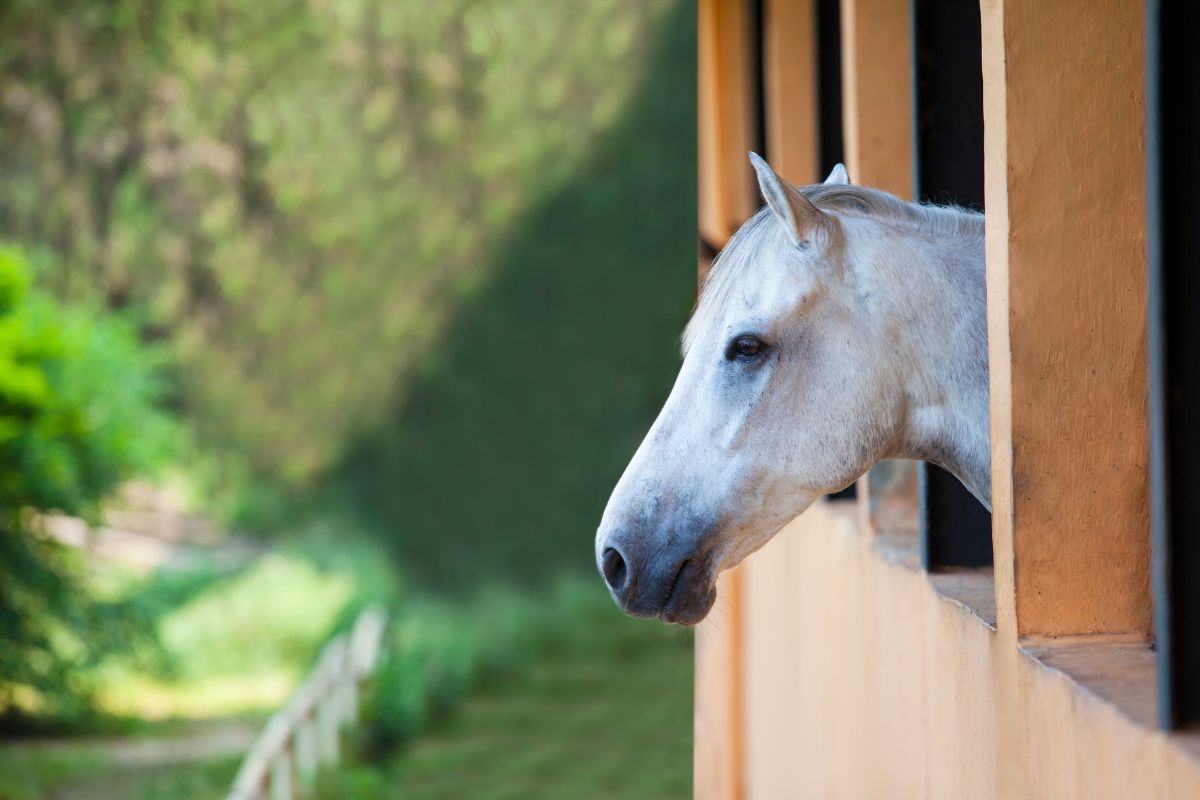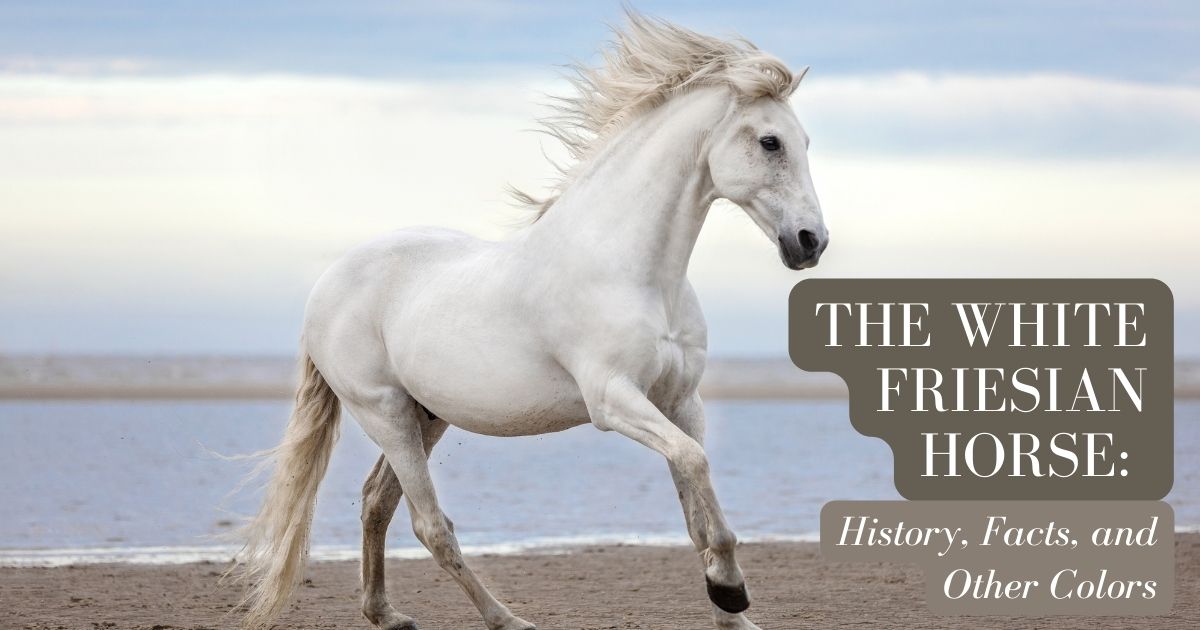What is a White Friesian Horse?
The White Friesian horse, also known as the White Friesian or the Friesian White, is a rare color variation of the Friesian horse breed. This breed is known for its black coat color, although some Friesians may also have a chestnut or bay coat.
White Friesians, on the other hand, have a white or nearly white coat color resulting from a genetic mutation.

The Friesian Horse Price
The price of this breed can vary widely depending on several factors, such as age, gender, bloodlines, training, and conformation. On average, you can expect to spend around $30,000 or more for a Friesian horse. Some factors that may influence the price are:
- Age and gender: Younger horses are less expensive than older ones. Also, mares may be less costly than stallions or geldings.
- Bloodlines: Those with well-known origins, successful show records, and prestigious breeding may command a higher price.
- Training: Friesians that have undergone extensive training in dressage or other disciplines may be more expensive than untrained horses.
- Conformation: Horses with desirable physical attributes, such as good bone structure, straight legs, and a well-shaped head, may be priced higher.
- Market demand: The popularity of Friesian horses in a particular region or market can also affect the price.
It’s important to note that the cost of purchasing this breed is just the beginning. These horses also require proper nutrition, veterinary care, and other expenses such as tack, stabling, and transportation. Researching and understanding the costs of owning Friesians before purchasing is essential.
Friesian Horse Characteristics
Here are some of the critical characteristics of the Friesian horse:
They Have Long Manes and Tails
This breed is easily recognizable due to its black color and long mane and tail, which sometimes touch the ground. Additionally, Friesians have long hair on their legs, called feathers, extending from the middle of the leg down to the ankle.
Friesians are Powerfully Built
The Friesian is a big horse with a strong and bulky body. While the average height for this breed is 15.2 hands, it’s not unusual to come across ones that are 17 hands tall.
They feature a sturdy build with robust hindquarters and a low-set tail. They also have an arched, lengthy neck, a small, well-defined head with widely spaced eyes, and short ears.
They have compact and muscular shoulders and short, strong legs relative to their body. There are currently two types of Friesian horses: the baroque type and the sport type. The baroque type has a classic-looking body with thick bones and a heavier build. The sports type, on the other hand, is thinner and more frequently used in shows. Both types display high knee action.
They Are Kind and Gentle
They are known for their kind and gentle temperament; people often describe them as intelligent, willing, and eager to please. They are often used as riding horses, for carriage driving, and other equestrian pursuits.
They Are Versatile
Friesians are versatile horses that excel in various disciplines, including dressage, carriage driving, and pleasure riding. They are known for their athleticism, agility, and trainability.
The Different Friesian Horse Colors
Here are some of the different colors and patterns that can occur in this breed:
- Black: Black is the most common and traditional color for Friesian horses. Black Friesians have a solid black coat that is typically very shiny and lustrous.
- White: White Friesians are rare but becoming more common due to selective breeding. As the name implies, these horses have a white coat color, which can include a white mane, tail, and feathers.
- Chestnut: While less common than black, chestnut is another color that can occur in these horses. Chestnut Friesians have a reddish-brown coat with a flaxen or white mane and tail.
- Bay: Bay is another less common color that can occur in this breed. They have a brown coat with black points (mane, tail, and lower legs).
While black is the most common and traditional color for Friesian horses, breed registries recognize all these colors and patterns and can produce beautiful and unique horses.
Friesian Horse Height and Weight
These horses are known for their majestic appearance and impressive size. Here are some general guidelines for the height and weight of this breed:
Friesian Horse Height
The average height of a Friesian horse is around 16 hands.
Friesian Horse Weight
They weigh anywhere from 1200 to 1500 pounds (544 to 680 kilograms). The weight of this breed will vary depending on its height, age, and overall condition. It’s important to note that these are general guidelines, and individual horses may differ in size and weight.
People consider them a “heavy” horse breed, meaning they have a sturdy and muscular build. Their weight and size contribute to their impressive presence and make them well-suited for carrying riders or pulling carriages.
The Origins of the Friesian Horse
The Friesian horse came from Friesland, a province of the Kingdom of the Netherlands located in northwest Europe. Friesland dates back to 500 B.C. The Friesians who settled along the North Sea coast were traders, sailors, farmers, and horse breeders.
Initially, their owners used them for farm work, transportation, and war horses. Their strength, agility, and gentle temperament determined their price, and knights in battle often used them. In the 16th and 17th centuries, these horses became popular as carriage horses, and owners used them to pull carriages and coaches for the wealthy.
Over time, this breed evolved into a more refined and elegant horse with a distinctive black coat, flowing mane, and tail. Today, these horses are primarily for dressage, carriage driving, and pleasure riding and are known for their athletic ability and gentle nature.
These horses are essential to Dutch culture, and they celebrate them for their beauty and history. Several Friesian horse shows and events are held annually in the Netherlands, including the annual Friesian horse show in Leeuwarden, one of Europe’s most famous equestrian shows.
Interesting Friesian Horse Facts
These horses are a unique and majestic breed with a rich history and many interesting facts. Here are some fun Friesian horse facts:
They Have Unique Gaits
They are known for their beautiful floating trot and canter. This gait is known as the “Friesian Concourse” or “Tölt” and is unique to this breed.
They Have Feathers Around Their Hooves
Feathers are typically not trimmed or shaved to showcase their natural appearance. However, this can increase the likelihood of skin infection and the growth of bacteria. Maintaining clean conditions and providing proper care for the horse is crucial to prevent skin issues like rain rot.
This is particularly important to keep in mind for Friesians, who have their own unique Keuring.
Keurings are annual horse shows that take place in the Netherlands. At these events, the judges inspect these breeds for conformation and suitability for breeding.
Friesian Horses Live a Long Time
A Friesian horse’s lifespan is relatively long, with the average horse living between 20 and 30 years. They can even live longer than this with good care and proper nutrition.
The Friesian Breed Were Once Very Close to Extinction
In the early 1900s, the Friesian horse breed faced the danger of extinction. However, now it has become a significant part of the Dutch horse population. These horses are well-known for their beauty and grandeur, which have captivated people throughout history.
Not All Friesians Have Black Coats
Friesian horses may be best known for their rich black coats, but they can also have bay or chestnut colors. For purebred registration, the only acceptable white marking on a Friesian is a small star on its forehead.
Some Friesian horse associations do not permit the registration of horses with chestnut and bay coloring. Nonetheless, the American Friesian Association allows the registration of chestnut Friesians.
Friesian Horses Have a Calm and Steady Personality
Although initially, the owners used them in battle a long time ago, this horse breed is known for its loyal, willing, and cheerful temperament. Movie producers often use them in filming due to their gentle nature and ability to take direction easily.

What Are Friesian Horses Used for?
These breeds are versatile animals that you can use for various purposes. Here are some of the most common uses of these horses:
Friesians Compete in Dressage
These horses have a successful history of performing in dressage competitions, with the modern type being more suitable for contemporary competitions. This makes them an excellent option for dressage competitions where they must maneuver in tight spaces and make swift turns.
Friesian Horses Are Used to Pull Carriages
These horses are great for pulling carriages because of their smooth movements and strong hind legs. Historically, families often used carriages as their primary mode of transportation before the industrial revolution.
To make a good carriage horse, they must be calm, physically robust, sturdy, and have a wide stride. There is a unique carriage made exclusively for these breeds, known as the Friesian Sjees. Those involved in crafting the carriages did them uniquely with expertise.
Friesians Are Good Trail-Riding Horses
Trail riding offers outdoor enjoyment and exercise, and Friesian horses are ideal. They are a great choice if you’re a beginner rider looking for a horse that is easy to handle and has a stable footing.
They Are Used in Movies and Television
These horses get selected for roles in movies and television due to their graceful appearance and muscular physique, which make them ideal for playing heroic characters. Additionally, their relaxed demeanor allows them to work for extended periods on set.
Friesian horses have appeared in famous movie scenes, such as the charge of the Rohirrim in Lord of the Rings and the approach of the White Walkers in Game of Thrones. This has contributed to the horses’ association with Hollywood glamour, and their popularity remains strong.
This horse breed is a popular choice for film and TV, mainly for historical and fantasy dramas. They first gained popularity in the 1985 movie “Ladyhawke” and have remained a favorite in the entertainment industry ever since.
The Friesian Horse’s Lifespan
Like most horse breeds, the Friesian horse typically has a lifespan of around 25 to 30 years. However, the lifespan of any individual horse can be affected by various factors such as genetics, environment, and overall health.
They can live long and healthy lives with proper care, nutrition, and exercise. Regular veterinary check-ups, dental care, and vaccinations can help ensure the horse’s overall well-being. It’s also essential to provide them with proper nutrition, including a balanced diet of hay, grains, and supplements, as well as access to clean water and adequate exercise.
Overall, while the lifespan of these horses can vary depending on individual circumstances, they have the potential to live well into their twenties or even thirties with proper care and attention.
Friesian Horse Temperament
They are intelligent and quick learners, making them easy to train and handle. They enjoy interacting with people and thrive on attention and affection. Despite their calm demeanor, Friesians can be spirited and energetic, especially at work or in the show ring.
Their kind, gentle, and affectionate demeanor makes them popular for riders of all levels and disciplines.
Friesian Horse Speed
Although Friesians are not the fastest horse breed, they can still reach impressive speeds of 40 to 50 miles per hour (64 to 80 kilometers per hour.
They are fast and recognized for their ability to move easily and quickly.
Is a Friesian Horse High Maintenance?
Owning a Friesian horse requires significant effort and dedication to groom them and ensure they are healthy and fit.
The Friesian’s Grooming Requirements
Grooming is an essential aspect of owning any horse. Here’s what you need to know about grooming the Friesian horse:
Wash Feathers
To prevent skin irritations, wash the feathers with an anti-bacterial shampoo, then use a towel to dry them and finish with a blow-dry. It is vital to ensure no moisture is left on the skin as this may cause skin sores, which can be challenging to manage.
Horses with feathers often suffer from pastern dermatitis, a skin irritation affecting their lower legs. In some cases, the condition may even extend up to the knee. Neglecting the problem can result in swelling of the entire leg, along with oozing scabs and sores. It is advisable to practice good grooming habits to prevent such conditions.
Coat Care
Avoid turning them out during bright sunlight to maintain the shine in a jet-black horse coat, as it can cause bleaching. Additionally, feeding them a proper and highly nutritious diet can promote healthy and shiny skin.
To improve your horse’s skin condition, using the Medi-Care Med Shampoo W/Tea Tree & Lemon Grass on Friesians is recommended, as they tend to have dry skin. Additionally, when washing your horse, using a color-enhancing shampoo such as Shapley’s Hi Shine Shampoo in a 1-quart (0.946 liter) bottle is essential.
Brush Out the Tail and Mane
To maintain the horse’s mane and tail:
- Use a wide-tooth comb and detangler like Premium Showsheen and brush daily.
- Start combing from the bottom to avoid hair loss.
- If the fur is exceptionally long, consider French braiding it.
Housing
Friesians are more suited to live in colder climates as they struggle to handle heat. Anhidrosis is a common condition they suffer from, where they have difficulty sweating. In warmer weather, this condition can lead to severe issues.
It’s essential to watch these horses for anhidrosis curing hot months. Treatment options that have proven effective include giving them vitamin E injections and fluid and electrolyte injections.
Most horses with anhidrosis typically show improvement when relocated to cooler climates with lower humidity or kept in barns equipped with air conditioning.
Genetic Disorders Associated With Friesians
The Friesian breed of horses is more prone to genetic disorders due to years of inbreeding. Below is a list of some frequent diseases linked to this breed.
- Dwarfism: Friesian horses with dwarfism have a typical head size, but their bodies are more extended, and their limbs are extremely short, while their chests remain full.
- Hydrocephalus: The term used to describe the accumulation of cerebrospinal fluid in the brain, which causes pressure on the skull and can result in various adverse health effects.
- Aortic rupture: Aortic rupture is when the aorta, the body’s main artery, ruptures. This can lead to severe bleeding and even death.
- Megaesophagus: Megaesophagus is a throat condition that can cause a horse to choke. It enlarges the throat, making swallowing and digesting food difficult for the horse.
- Equine polysaccharide storage myopathy: Also known as EPSM, this condition is caused by the inability of the muscles to store and metabolize stored sugars. This results in muscle weakness and abnormal gait. In extreme cases, it displays symptoms that resemble colic. On some occasions, you manage it effectively with dietary changes.
- Digestive system disorders: Compared to other breeds, Friesians are more susceptible to colic and other gastrointestinal issues.
- Hypersensitivity to insect bites: Friesians are highly sensitive to insect bites from mosquitoes and horseflies, which can cause significant hair loss and skin damage on their mane, tail, head, and stomach. This hypersensitivity can be so severe that some horses become unusable for extended periods due to the severity of the skin damage.
- Pastern dermatopathy: In the past, owners knew Friesian horses had a higher tendency to develop skin diseases in their pastern area, particularly where their feathers grow.
Friesian Predicates Explained
The Friesian horse is unique because it has a set of predicates defining the breed’s characteristics. These predicates are the foundation of the Friesian horse and include body type, movement, bone structure, conformation, and color.
These predicates judge each horse and determine whether they meet the breed standard.
Below are the essential predicates for Friesian horses:
Crown/Kroon Predicate
For a horse to be eligible for the crown predicate, it must meet the following criteria: it must be at least three years old and have scored at least 77 points at an IBOP or ABFP event. Additionally, the horse gets examined at a walk and trot and obtains an average score of 7 points. Finally, the horse must also be at least 15.2 hands tall.
Ster Predicate
To be eligible, horses must be at least 15.1 hands tall and undergo an examination while being led by hand at a walk and trot. Male horses are examined at two years old, while female horses and geldings must be at least three years old.
Sport Predicate
To qualify for dressage, horses must score 60% or higher at the 3rd level or above at least five times. For carriage driving, horses must earn 10 points by completing at least three FEI Test #9.
Model Predicate
The Fresian mares that meet the specific criteria receive the “highest quality” classification. These mares must have given birth and be at least seven years old. Their athletic ability and breed characteristics determine their evaluation. It is rare for mares to receive this prestigious classification.
Preferent for Stallions
Stallions can achieve preferent status by producing high-quality offspring that meet the desired breeding goals and attributes. These offspring get tested and evaluated, and the stallions that pass the criteria receive the preferent stallion status.
Are Friesians Warm-Blooded?
Yes, Friesians are warm-blooded horses. The term “warm-blooded” refers to a category of horse breeds that exhibit characteristics of both cold-blooded and hot-blooded horses. Warm-blooded horses, including Friesians, result from crossbreeding between cold-blooded draft horses and hot-blooded breeds.
What is a Friesian Keuring?
At a Friesian Keuring, horses get judged on various factors, including conformation, movement, and temperament. The judges will evaluate the horse’s overall appearance, looking at its head, neck, shoulders, back, and hindquarters and its movement at various gaits, such as walk, trot, and canter.
The judges evaluate the horses based on their temperament and trainability, as well as their pedigree and breeding history. They will then assign a score to each horse based on its overall quality and suitability as a breeding or performance animal.
Friesian Keurings are essential events for Friesian breeders and owners. They provide an opportunity to showcase their horses, learn about their strengths and weaknesses, and network with other breeders and enthusiasts. The events also promote and preserve the Friesian breed and maintain its high standards of excellence.
Are Friesians Good Jumpers?
You can train Friesians to jump for fun, but their large body size makes them unsuitable for high-level jumping competitions, so we can’t consider them good jumpers.

That’s a Wrap
The White Friesian horse offers a unique glimpse into the past, and people consider it one of Europe’s most iconic equine breeds. Its noble, strong, and courageous appearance has witnessed centuries of man’s history. While their dreamy white coat is perhaps their most distinguishable trait, they also come in rare black, chestnut, or bay colors.
These gorgeous horses are a reminder that no matter how much time passes, some things remain timelessly beautiful. Whether you’re a lover of animals or intrigued by their majesty, the White Friesian Horse will be sure to keep you spellbound as it caters to your every need.
Ultimately, this majestic creature is bred for beauty and nurtured with devotion and love – something we can all strive for regardless of our paths in life. Taking pleasure in its grandeur and complexity can be a valuable asset to anyone willing to observe the regal beast.
